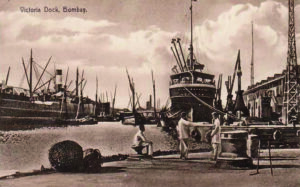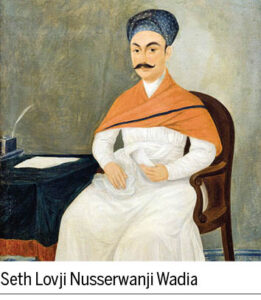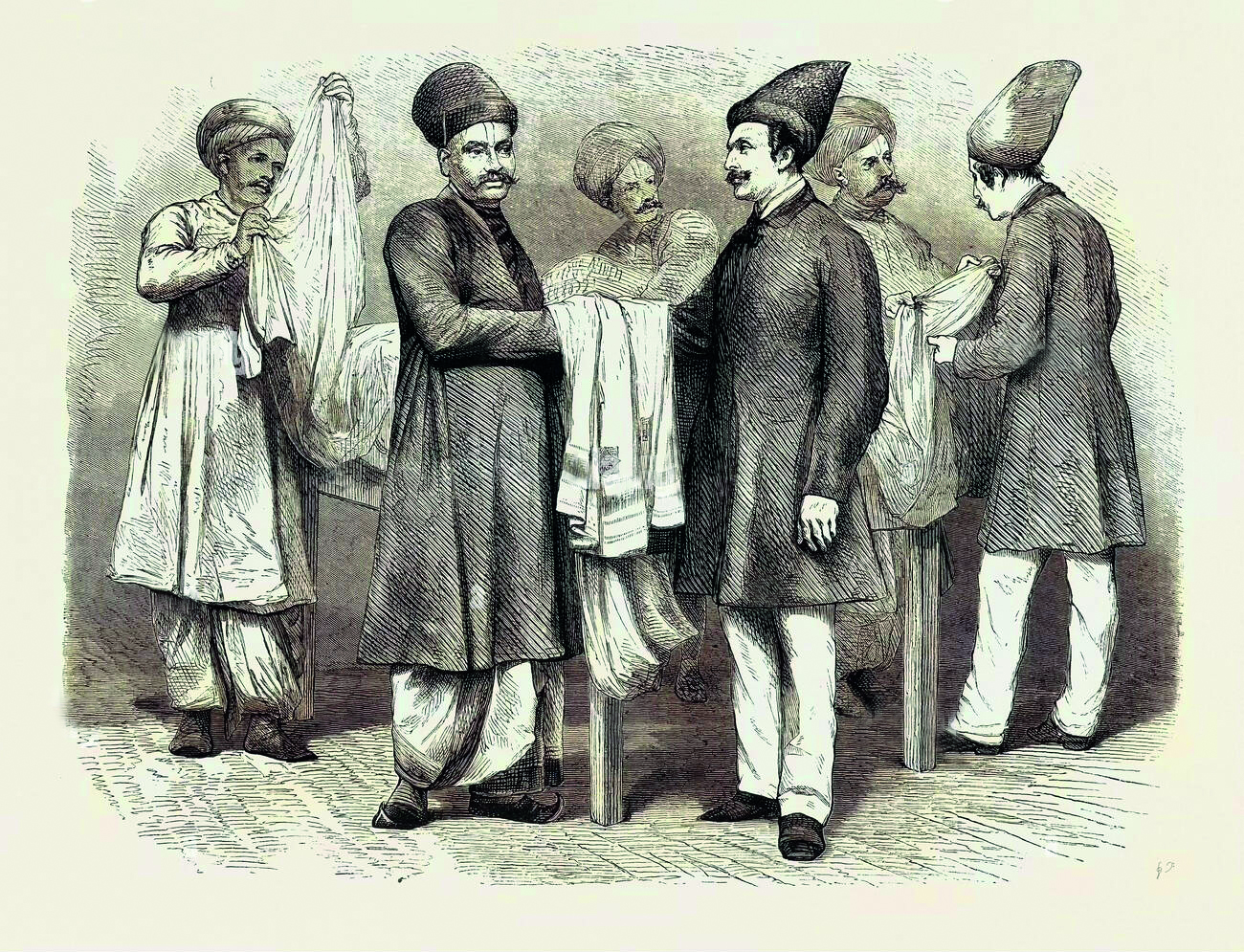Parsi Times presents a 5-part series on the entry, settlement and rise of the Parsi community in India, by Adil J. Govadia.
 In the 16th century, the shipping industry began to flourish in Surat as mostly all trade was done by sea. Surat being an important sea port, the Portuguese, French and the British maintained their respective trading posts, since early 15th century. Surat’s Wadia family emerged as master ship-builders, soon growing a global reputation for their high standards of workmanship and maintenance. In fact, in 1750, the Bombay Dock (Asia’s very first dry-dock), was built by Parsi siblings – Seths Lovji and Sorabji Nusserwanji Wadia. Hailed as founders of the shipping industry in India, their descendants constructed ships in Surat and Bombay that have sailed across the seven seas, from Europe and the Americas to the ancient shores of Africa and China. Seth Lovji was succeeded by his sons Maneckji and Bomanji Wadia, who further expanded their shipbuilding services.
In the 16th century, the shipping industry began to flourish in Surat as mostly all trade was done by sea. Surat being an important sea port, the Portuguese, French and the British maintained their respective trading posts, since early 15th century. Surat’s Wadia family emerged as master ship-builders, soon growing a global reputation for their high standards of workmanship and maintenance. In fact, in 1750, the Bombay Dock (Asia’s very first dry-dock), was built by Parsi siblings – Seths Lovji and Sorabji Nusserwanji Wadia. Hailed as founders of the shipping industry in India, their descendants constructed ships in Surat and Bombay that have sailed across the seven seas, from Europe and the Americas to the ancient shores of Africa and China. Seth Lovji was succeeded by his sons Maneckji and Bomanji Wadia, who further expanded their shipbuilding services.
Admiral Sir Edward Hughes, Naval Commander-in-Chief, East Indies Station, was so impressed by the quality of Parsi shipbuilding techniques that, on his recommendation, a massive land-parcel was gifted to the Wadia brothers located in Bombay’s Parel area. They were succeeded by their respective sons, Seths Framji and Jamsetji. Framji died rather young but Jamsetji was a naval architect of great repute with the British Admiralty committing to have their ships built at the Bombay Docks, under his supervision.
The 72-gun ship, named ‘Minden’, established Seth Jamsetji’s reputation in England. He was presented a silver vase for his meticulous workmanship and proficiency. The Bombay Government also granted him the villages of Vile Parle and Juhu, in appreciation of his services. In 1817, Seth Jamsetji built a teakwood frigate named HMS Trincomalee, which is displayed even today at the Hartlepool Historic Quay, in England. Known as the ‘oldest ship afloat’ in the UK, she served the Bombay Docks for almost 50 years.
Seth Jamsetji died in 1821, succeeded by his son, Seth Navroji Wadia, who sustained the family tradition, building the ship ‘Asia’ (launched in 1824), which became the Flagship of Admiral Sir Edward Codrington, at the battle of Navarino, fought in 1827. Seth Navroji was the last of the master ship builders as, in 1831, the British Government decided not to build ships in Bombay. He eventually retired in 1844 after serving the Bombay dockyard for 54 years. When he passed in 1860, the dockyard was closed and flags of all vessels in Bombay harbor were flown at half-mast, as a mark of respect to the legendary ship builder. 1913 marked the conclusion of the great legacy of Seth Lovji Wadia and his family, after 178 years of quality ship-building, having constructed 345 ships of various kinds. (Ref. HD Darukhanawala’s ‘Parsi Luster on Indian Soil’).
Just like Surat excelled in ship building, the city of Bombay owes its prominence to cotton trade and textile mills, responsible for establishing the metropolis as the financial capital of India. In turn, the textile industry owes its success and glory to the foresight of Parsi pioneers who initially laid the foundation of the cotton mill industry in India!
 Parsi trailblazers voyaged across seas in small vessels to barter in Indian commodities for expensive Chinese silks. Parsi families like Sir Jamsetjee Jeejeebhoy, Sir Cowasjee Jehangir, Sir Homi Mehta, Seth H F Commissariat, Seth P N Mehta, the Petits, Camas, Davers, Readymoneys and many more amassed great wealth and prominence in the cotton mill industry and trading with China. Seth Cawasji Nanabhoy Daver founded the first cotton mill – Bombay Spinning & Weaving Company in 1854, followed by another ‘Throstle Mill’ in 1857, which thrived and was later sold off due to internal management issues.
Parsi trailblazers voyaged across seas in small vessels to barter in Indian commodities for expensive Chinese silks. Parsi families like Sir Jamsetjee Jeejeebhoy, Sir Cowasjee Jehangir, Sir Homi Mehta, Seth H F Commissariat, Seth P N Mehta, the Petits, Camas, Davers, Readymoneys and many more amassed great wealth and prominence in the cotton mill industry and trading with China. Seth Cawasji Nanabhoy Daver founded the first cotton mill – Bombay Spinning & Weaving Company in 1854, followed by another ‘Throstle Mill’ in 1857, which thrived and was later sold off due to internal management issues.
In 1756, Seth Hirji Jivanji (Readymoney), one of India’s first Parsi merchants, set up a trading firm in Canton, followed by other pioneering Parsi trading families like the Wadias, Banajis, Vikajis, Camas, Parakhs and Jeejeebhoys. A very influential and impactful merchant from Surat, Seth Ratanji Maneckji (1733-1804), was nicknamed ‘Enti’ (obstinate) for his unyielding attitude. He once distributed food-relief for the famine-stricken people of Gujarat in 1790, insisting on receiving a few coins in exchange for his generosity! Owing to this stubbornness, he was nicknamed Enti, and every newly minted coin thereafter, was named ‘Entisahi Rupee’ after him!
Seth Ardeshir Dhanjisha Kotwal Bahadur was the Warden-General of Surat, under the East India Company. Born to a prominent Parsi officer who was murdered, he belonged to the blue-blooded family of Beheraman Khan and rose to become the Chief of Police and a Magistrate of great standing. Almost seven feet tall, Seth Ardeshir was decorated with medals and regalia by the British military, and also granted jagir (estate/property) of eighteen villages around Surat. Looked upon as a Nawab, Seth Ardeshir was the first to form the Surat Parsi Panchayat with the help of Sir Jamsetjee Jeejeebhoy, 1st Baronet.
His selfless service during the floods and fires of Surat made him legendary, remembered even today. He donated generously to help those rendered bankrupt by the calamities. Ironically, despite his munificent charities to individuals and religious institutions, including mosques and Hindu temples, he died penniless and insolvent! In appreciation of Seth Ardesir’s unstinting generosity, the founder of the Swamy Narayan sect once paid him a special visit, presenting his own turban to him, as an indication of profound respect. Since then, the turban has remained an object of annual worship and pilgrimage by the Swamy Narayana faction.
Seth Dossabhai Framji Mama, a well-known merchant, was the direct descendant of the Dadyseth family. His father, Seth Framji was the maternal uncle to the Dadyseth brothers – Seths Cursetji and Jehangir, who fondly addressed him ‘Falaji mama’, and thus originated the surname, Mama. Seth Dossabhai Mama was a well-known trader around the Malabar Coast and in Muscat. In partnership with Sir Cowasjee Jehangir, he became a broker in the firm Duncan Gibbs and amassed a large fortune. His eldest son Seth Byramji Mama married Bai Shirinbai, daughter of Seth Cawasji Nanabhoy Daver, founder of the textile mill industry in India and had three sons and a daughter. Their eldest son Khan Bahadur Dr. Jamshed Byramji Mama, was the Director of the Vaccine Institute at Belgaum.
- બરોડાની કોન્ટ્રાક્ટર આદરિયાને 102માં સાલગ્રેહની ઉજવણી કરી - 8 March2025
- વિસ્પી ખરાડીએ નવો ગિનિસ વર્લ્ડ રેકોર્ડ બનાવ્યો - 8 March2025
- પારસી મહિલાઓનું સશક્તિકરણ:મહિલા દિવસનું મહત્વ - 8 March2025
